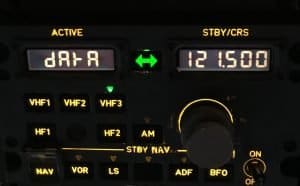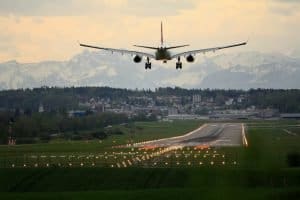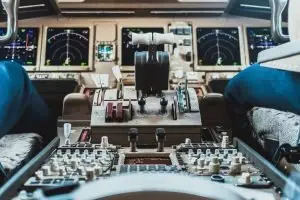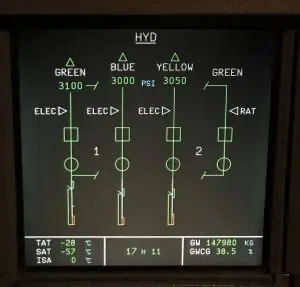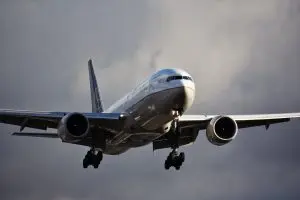An APU (auxiliary power unit) works in a similar way to an aircraft’s engine and has three roles: to supply conditioned air to the cabin, as a source of electrical power for the aircraft and lastly as a means of engine starting.
Many of these roles are used routinely in day-to-day flying, but the APU also serves as backup in the event of a technical failure to regain a supply of air or electricity, or to assist in the restarting of an engine in flight.
Did you ever notice when catching a flight as you board the aircraft it sounds as though one of its engines is running? Well thats actually the sound of the Auxiliary Power Unit running.
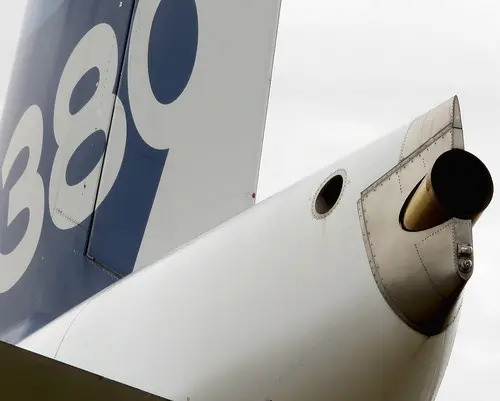
Table of Contents
How does an APU work?
APUs are normally installed in the tail of an aircraft and operate on a similar principal to a jet engine – turbine etc. Fuel is supplied from the main aircraft fuel tanks through a series of pumps and fuel lines, and the exhaust exits overboard from the tail.
Photo Credit: Pit Spielmann Flickr
What is an Auxiliary Power Unit used for?
Air is taken from an inlet (normally under the aircraft) and this is cooled and conditioned in the air conditioning system and then supplied to the cabin for passenger comfort. In warm moist air the cooling of the air can cause moisture present to condense and this can appear as fog/smoke coming from the air conditioning vents.
The APU also has the ability to supply electrical power to some or all of the aircraft systems via a built-in electrical generator. This is often used on the ground just prior to pushback, when the aircraft will be disconnected from the airport ground electrical system (either a mobile ground power unit. GPU, or a fixed electrical power FEP) or just as the aircraft arrives on stand before any external electrical power has been connected.
“Though failures are rare, sometimes the failure of the APU or the ground power unit will result in a loss of electrical power to the aircraft – and if its at night the aircraft will be plunged into darkness (apart from the emergency exit lights which are supplied by the aircraft batteries)!”
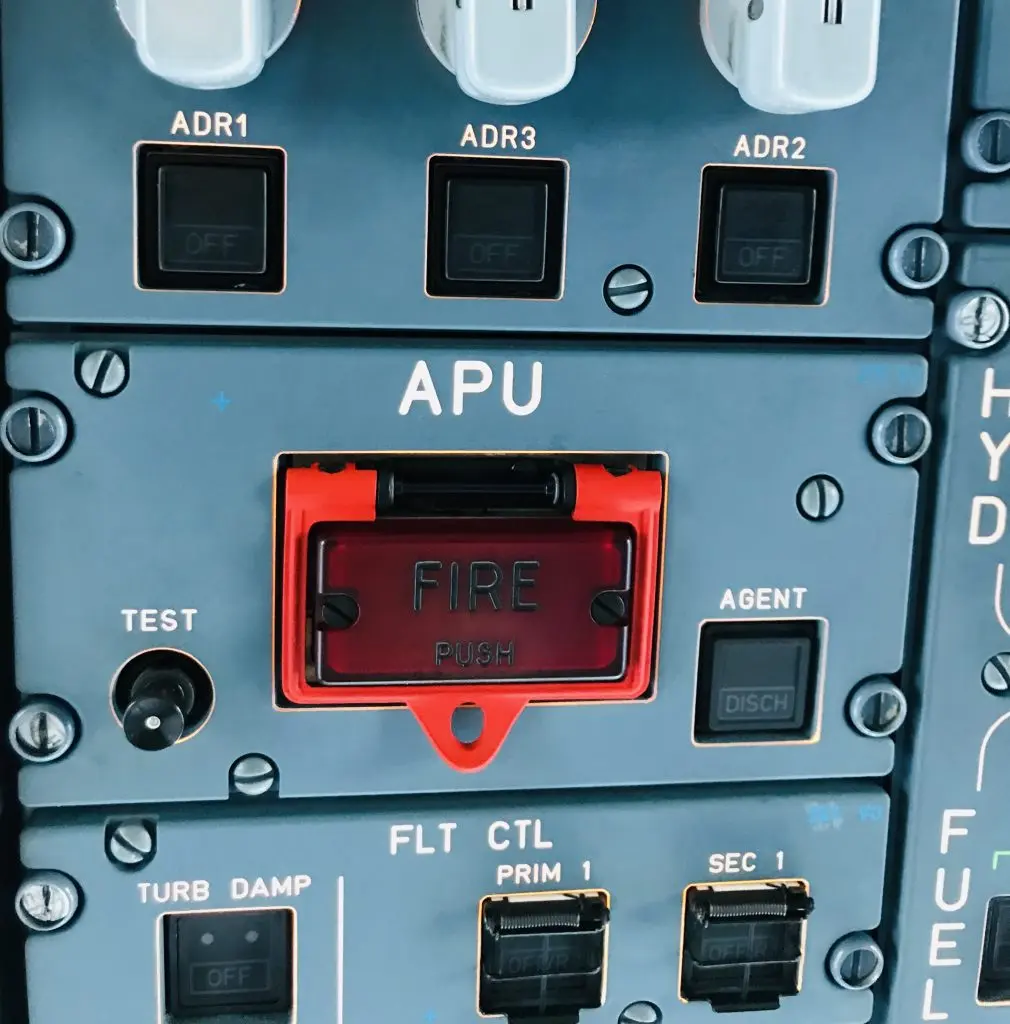
The last role the Auxiliary Power Unit can be used for is engine starting. Aircraft with smaller engines can use electrical motors to begin the initial rotation of the engine (until the turbine takes over and the engine is “self sustaining”). However the engines on bigger airplanes, such as wide-body aircraft, would be too heavy to be rotated by electrical motors (or indeed, the required motor would be so big and heavy that it wouldn’t be efficient) that air from the APU (or an external air source – an “air start cart”) is used to start the engine.
How is an APU used in flight?
Generally the pilot will shutdown the APU after engine start when the engines running normally and they have taken over the supply of both electricity to the aircraft and air conditioning to the cabin. However sometimes the APU may be left running:

For performance reasons: sometimes with a heavy aircraft on a to day the engines at take off thrust will be producing close to their maximum thrust. If the engines were supplying conditioned air to the cabin this reduces the maximum thrust available at take off. In this instance the APU is left running to supply air to the air conditioning “packs”, leaving TOGA (Take-Off, Go-Around) thrust an option which is the maximum trust available for departure. The thrust required will vary depending on the atmospheric conditions (wind velocity, temperature, pressure etc.) and aircraft weight.
Learn about factors affecting take-off performance here.
Usually in this case, at a suitable time after departure when maximum thrust is no longer required of the engines, the APU air supply will be switched off, and when its confirmed the engines have taken over the task of air supply and are operating normally, the APU will be shutdown.
To supply electricity: if the crew anticipate they may need to shut down the engines after pushback at some stage they may elect to keep the APU available.
When might pilots decide to shutdown engines during taxi? Perhaps they expect a large delay/groundstop or in winter operations they expect they may need to shut engines down during de-icing. (Often its not needed to shutdown engines to have deicing carried out but it depends on airport restrictions, location of the aircraft etc.).
To comply with the MEL: Firstly, what is the MEL? The “Minimum Equipment List” is a list of equipment that the aircraft requires that must be working correctly prior to departure.
Related reading: A Guide to the Minimum Equipment List
You might have assumed that you require ever part of the aircraft working 100% prior to departure, but this is not the case. For example, if a life raft is “INOP” (inoperable) the MEL may allow flights to dispatch as long as they’re not planned to operate over large bodies of water.
Or if one of the navigation lights is unserviceable, operations may be allowed during daylight hours only. If an electrical system on board the aircraft is “INOP” or degraded, the MEL may allow the flight to depart as long as the APU is left running as an alternative supply of electricity.
Related reading: INOP Items in Aviation
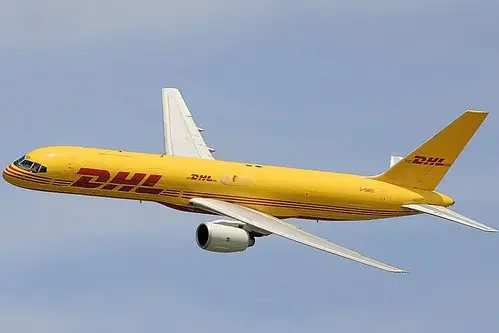
For example, let’s take a look at the Boeing 757 MMEL (Master Minimum Equipment List) available from the FAA here. On the contents page we see Airborne Auxiliary Power is listed under section 49. Let’s assume the APU is completely INOP (inoperative) – 11-1 tells us:
Number installed: 1
Number required for dispatch: 0
Remarks: Except for ER operations, may be inoperative provided:
a) Both engine generators operate normally, and
b) Procedures do not require its use.
We have 1 APU installed on the 757 but we don’t require it for departure, if we can comply with both of the remarks: a) refers to the that if the APU was INOP, and an engine generator, then we would have only one main source of electrical power (from the other engine) and this means we’d be in trouble if that generator failed in flight. In b), other procedures that might require the APU to run might be for performance reasons for example.
However, let’s assume one of the engine generators is faulty and has been deactivated – can we dispatch this flight? Section 24 Electrical Power, 00-1 Engine Generator Systems has our answer.
Number installed: 2
Number required for dispatch: 1
Remarks: Except for ER operations beyond 120 minutes, one may be inoperative provided:
a) APU generator operates normally and is used to supply busses of inoperative channel throughout flight
So this tells us we have two engine-driven generators (one from each main engine) – if one is operative we are allowed to depart, except for operations beyond 120 minutes (this refers to extended range/ETOPs flights) provided the APU operates normally, and we leave it running throughout the flight.
We would periodically monitor the APU status on the EICAS or ECAM, which is a way to display the various aircraft systems on screens in the cockpit.
Related reading: EICAS and ECAM Use in Aviation
This is one example of when we may leave the APU running rather than shutting it down after pushback.
What is means for parts of aircraft systems to be “INOP”.
Example: APU use during a typical flight
Imagine our flight today is an early morning departure from Dallas Fort Worth (DFW) to Cincinnati (CIN). The aircraft is just out of maintenance and is parked remotely with no ground power available.
Let’s assume the regular pre-departure checks are completed as normal, and focus on the Auxiliary Power Unit for our example. The aircraft is dark and one of the first goals of the day is to get power supplied to the aircraft (and the coffee brewing!).
Upon entering the flight deck you will first check the CB’s to ensure none have “popped” or been pulled by maintenance. (CB’s, circuit breakers, are like resettable fuses that “pop” out a little to isolate the system in the event of an over current, for example. Also the engineers may pull the CB’s breakers if they want to remove electrical power from a system they’re working on). Some EICAS and ECAM systems also indicate CB status.
Assuming all your CB’s are in place, your next task is to check the state of the aircraft batteries. On the overhead panel you will be able to view the voltage to ensure the batteries and in good health – larger commercial aircraft often have two main batteries with a third for APU supply.
Lastly, its important to push the “fire test” button to ensure the extinguisher system is available in the unlikely event we need it.
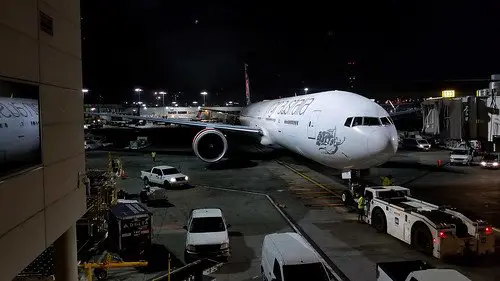
Assuming all is in order, it’s time to start the APU.
On older aircraft you had to make sure the APU GEN (generator) was selected off, the relevant fuel pump selected on, and then the start had to be monitored to ensure it was normal and no limits were exceeded.
On modern aircraft this is a mostly automatic process requiring one or two buttons to be pressed, with the system automatically monitoring the start and in the event of a fault or fire it will automatically abort the start and in the event of a fire, it will “fire” the APU extinguisher system (depending on the aircraft).
Once the APU is running normally, its generator will kick in and the aircraft with burst into life with the displays powering up and lights coming on (and most importantly the boiler will start to heat the water).
After the cabin crew/Flight Attendantss drop a hint about how cold it is in the cabin you’ll remember you forgot to select the “APU AIR” switch on (of course you pretend you didn’t forget, you were just waiting for…something).
Once the cabin is warm, the coffee is brewed, the crew are happy and the bags are loaded, it’s time for us to get out of here.
With our checks completed and clearance from ground control to start our engines, we select engine number 2, and “START”.
The system will divert the APU air supply from the cabin to the engines where we now need it to turn the engines (remember on larger aircraft using an electrical motor to turn the engine wouldn’t be feasible).
In the cabin the passengers will notice the air has stopped flowing from the “gasper” vents above their seats until engine start is complete and the air supply has been restored to the air con packs.
APU Monitoring
APUs these days are very reliable and rarely cause problems. But the fact that it’s essentially a controlled fire in the tail means its important its monitored.
On older aircraft we used to regularly keep the APU panel in”our scan”. Usually it was on the overhead panel with indications of operating temperature, operating speed as RPM and a number of warning lights (low fuel pressure etc.).
These days the monitoring is a lot more automated. Often the APU with automatically shutdown if it detects a serious fault or fire, even going so far as to automatically discharging the fire extinguisher it contains.
Even on modern aircraft it’s still important for pilots to monitor its performance and that is done by a system such as ECAM (Electronic Centralized Aircraft Monitor) or EICAS (Engine Indicating and Crew Alerting System) are systems that allow the APU (and other aircraft systems) to be displayed on a screen in the flight deck. In the event of a failure the ECAM/EICAS will provide crew with guidance on dealing with the malfunction.
On older aircraft without EICAS or ECAM, if a warning occurs the crew will consult the Quick Reference Handbook (QRH) which will detail the relevant procedure depending on the failure.
Related Reading: How pilots deal with failures using the Quick Reference Handbook (QRH).
Auxiliary Power Unit Cockpit Display

The above image from the ECAM of an Airbus A330 shows the APU page selected in flight. (We know its in fight because with a temperature of -56ºC, or -69ºF, it would be a very cold walk-around!)
The amber ‘XX’ on the N (rotor speed) and EGT (Exhaust Gas Temperature), and on the bleed pressure indication, show the APU is not in use.
Also the white “APU GEN” indication at the top left shows the APU’s generator is not available as a power source for the aircraft.
Video of Auxiliary Power Unit/APU
Here’s a good video showing how pilots interact with the APU and how we control it from the flight deck.
Frequently Asked Questions about the Auxiliary Power Unit (APU)
What is the difference between an APU and a GPU in aviation?
The APU (Auxiliary Power Unit) is the power unit contained on an aircraft which can provide electrical and pneumatic (air) power. The GPU (Ground Power Unit) is connected by the ground crew when the aircraft arrives at the gate an provides electrical power only.
Another version of the GPU is FEP (Fixed Electrical Power).
What is the difference between a GPU and FEP?
A GPU (Ground Power Unit) is a generator that is connected to an aircraft when it arrives at the gate and supplies electrical power to the aircraft. Usually the term GPU refers to a mobile generator that is towed to the aircraft and then towed away once it is no longer required and has been disconnected. FEP (Fixed Electrical Power) usually refers to a system that is either connected from the airbridge or from the ground and is fixed in place and is not removed.
Can an aircraft dispatch if the APU is not working?
Yes in general aircraft can depart with an inoperative (INOP) APU’s. In flight the APU generally serves as a backup in the case of a failure of other systems (e.g. electrical failure).
Prior to departure the pilots will check the aircraft “tech log” (aircraft technical logbook) which will indicate if the APU is not working. The pilots will then reference the MEL (Minimum Equipment List) which detail if there are any restrictions on departing without the APU – for example, often for ETOPS (Extended Twin Engine Operations) the APU is required to be serviceable.
If you found this article interesting please take 5 seconds to share this on your favorite social media. Thanks so much, I really appreciate it! [email protected]
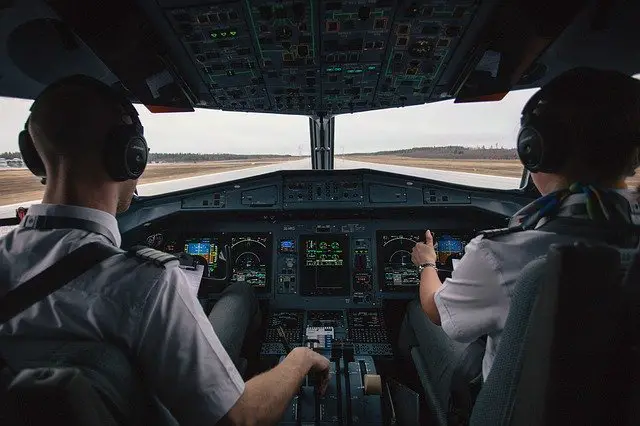
Pete has been flying aircraft for the last 20 years. He has flown everything from light piston aircraft up to heavy jets as both First Officer and Captain. He’s currently enjoying life flying the Airbus A330 for a major international airline.

